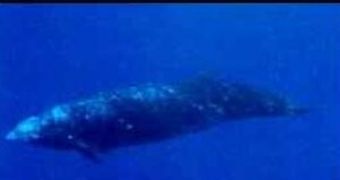Beaked whales get their name from the shape of their snouts and their large size, but these cetaceans are close-related to dolphins. This family of toothed cetaceans is amongst the least known mammalian families. They measure between 3,4 to 12 m (11 to 40 ft) length and weigh 1 to 15 tones.
They make deep dives and feed from the sea floor by suction feeding, without using their teeth (which are in fact deeply reduced in number of down to only 2).
Beaked whales are very little known because they spend little time at the surface and are difficult to tag. Cuvier's beaked whales (Ziphius cavirostris) dive to maximum depths of nearly 1,900 m (6,230 ft) with a maximum duration of 85 minutes"; this is the record for the deepest dive confirmed of any air-breathing animal. The average foraging dive for Cuvier's beaked whale is to a depth of 1,070 m (about 3,500 ft) with a duration of 58 minutes. These too represent the deepest and longest average dives reported for any air-breathing diving animal.
Now, a new research published in "Bioinspiration and Biomimetics" by a team from San Diego State University and the University of California, using computer models to imitate the effects of underwater noise, has found a new pathway for sound entering the head and ears.
Improved Finite Element Modeling (FEM), Computed tomography (CT) scanning, and computer processing allowed to mimic the environment and anatomy of a Cuvier's beaked whale when a sonar signal is expelled or received by the whale. FEM simulates in engineering the effect of an earthquake on a building. The geometry and physical traits of a building determine how the forces of an earthquake impact it; the technology can predict the same way the effects of the noise vibrations. CT scan came with a very complex anatomic geometry of the whale's head.
"I think that the methods developed for this research have the potential to revolutionize our understanding of the impact of noise on marine organisms," said lead researcher Dr. Cranford of San Diego State University.
The common theory emitted in 1968 says that noise vibrations go through the thin bony walls of toothed whales' mandible and onto the fat body surrounding to the ear complex. But this new research reveals that the bony walls of the mandible do not transmit the vibrations: actually they enter through the throat and reach the bony ear complex through a specific fatty channel.
Cuvier's beaked whale is rare and very little known, but the team chose to study it because of the several instances when this species had stranded after exposure to intense sound, like that caused by navy sonar.

 14 DAY TRIAL //
14 DAY TRIAL //